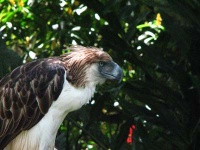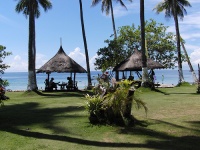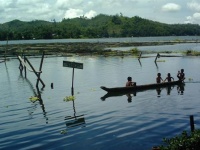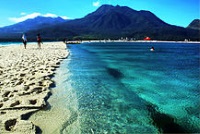Davao Travel Guide
Located in the Mindanao region, Davao City is the gateway to the southern Philippines. A beautiful landscape of hills and fertile valleys surrounds this hub of commerce and industry, with Mount Apo towering above all else. The potentially active volcano is the country's highest mountain.
Many indigenous tribes still inhabit the valleys outside Davao, such as the Bilaan, Bagobo, Mandaya and Manobo. Davao is also in the centre of the country's fruit and flower-growing zone. Travellers who visit in August can enjoy the annual Kadayawan Festival, which celebrates life and gives thanks for a bountiful harvest. Otherwise, the region is home to gorgeous dive sites, remote islands and tropical beaches. Nature lovers may see the endangered Philippine Eagle and the rare Vanda Sanderiana Orchid.
Sadly, travel authorities consider the region to be unsafe, as it suffers under a high threat of piracy and terrorism. Travellers who visit Davao should plan their stays carefully to ensure maximum safety, especially in remote areas.
Things to do in Davao
Though better-known as a gateway to Mindanao's countryside and ancient Filipino cultures, Davao City does indeed have a number of sights worth seeing.
People's Park lies within the city and is a good spot for a stroll and picnic. Visitors will find some shrines and temples in the area as well. The nearby Philippine Eagle Centre is a must for animal lovers, as it gives them a chance to see these amazing and seriously endangered birds of prey up close. Eden Park is also appealing. Nestled in the mountains above Davao City, the largely man-made nature resort has pools, wildlife and canopy walks.
Hikers can journey to the top of Mount Apo, which is the highest mountain in the Philippines. Many routes run up the mountain, taking travellers through dense tropical forest on the way to stunning views from the summit. The hike usually requires three days.
Davao has its share of paradise beaches too. Samal Island is just a short ferry ride away, and is home to caves, resorts, waterfalls and a white-sand coastline. In turn, Camiguin Island offers hot springs and volcanoes along with its pristine beaches.

Philippine Eagle Centre
The Philippine Eagle (also known as the monkey-eating eagle) is one of the world's largest and most powerful eagles. Tragically, it's also one of the rarest and is critically endangered. The only remaining members of the subspecies soar above the mountains of eastern Luzon, and the heavily forested areas of Mindanao. Animal lovers should visit the Philippine Eagle Center. Located in Malagos, which is near Davao City, the centre is home to a fair number of eagles, as well as mammals, reptiles and other bird species. The animals live in a simulated tropical rainforest. The centre is popular with tourists and allows them to see these rare and impressive creatures in their natural environment. Visitors must pay an entrance charge, though guided tours are free. They should also call ahead and book in advance, as the centre sometimes hosts large school groups.

Samal Island
A short ferry ride separates the island of Samal from Davao City. The destination is part of an archipelago of islets, which together provide a getaway from city life. Its calm waters, coral reefs and lovely beaches draw crowds of tourists, though the island has managed to retain its charm despite the influx. Visitors will long remember its sunsets, sunrises, rolling hills, mangrove swamps and tiny fishing villages. The island also has some gorgeous waterfalls and natural swimming pools. Regarding activities, hikers and spelunkers will find lots to keep them occupied. Tourists can enjoy a variety of watersports as well.

Lake Sebu
Travellers who seek 'off the beaten track' eco-adventures should head to Lake Sebu. Located on the island of Mindanao, the destination is surrounded by rolling hills and forested mountains, and is home to the T'boli: a highland tribe famous for their colourful costumes and intricate beadwork. Visitors will also encounter the Tasadays, who are a cave-dwelling people. The area's springs, waterfalls and natural caves are a delight. Thrill seekers should visit the Seven Falls Zipline too, as it's said to be the highest zipline in Southeast Asia. It takes travellers high above the region's thick jungle and beautiful waterfalls. Visitors who prefer to stay on the ground can choose from many wonderful hikes around the lake and to the falls. There are also many enticing boat trips, which allow travellers to explore the picturesque area and see how the locals live.

Camiguin
Situated on the north coast of Mindanao, the tiny island of Camiguin is renowned for the friendliness of its people. It's also distinguished for having more volcanoes than municipalities. Regarding its attractions, the destination is a relaxation seekers paradise, where hot springs and stunning beaches are the order of the day. Visitors can climb Mount Hibok-Hibok, and snorkel through a sunken cemetery too, reading gravestones that were submerged in a volcanic eruption. Culture lovers should stop at some of the island's remaining colonial homes, buildings and churches. Santa Rosario Church in Sagay, and the San Nicolas de Tolentino Church in Mambajao are among the island's best churches.
Philippines travel info
Electricity
Electrical current is 220 volts, 60Hz. Two-pin flat blade attachments and two-pin round plugs are used, with round two-pins being the most common.
Language
The official language of the Philippines is Filipino (a standard variant of the Tagalog language), but English is widely spoken. Tagalog is the most predominant of the many dialects or local languages spoken throughout the islands.
Money
The currency of the Philippines is the Peso (PHP), which is divided into 100 centavos. Major credit cards are widely accepted in cities and tourist destinations. ATMs are available in the major cities and in main centres on some islands. US dollars are widely accepted in Manila and other tourist areas, and are the easiest currency to exchange. Otherwise, euros and pounds sterling can also be exchanged in banks and hotels. Most banks in the Philippines are open from 9am to 5pm, Monday to Friday, but their ATMs are open 24 hours. It is best for travellers to carry pesos when travelling outside of major centres.
Tipping
Tipping is expected for most services in the Philippines. The standard practice is 10 percent of the total bill, although in some cases it can be only PHP 20-50. Tipping is optional on bills that already include a 10 percent service charge.
Health
No special vaccination certificates are required for the Philippines, except by travellers arriving from an area infected with yellow fever. There is a risk of malaria and dengue fever in more rural areas, while tap water is not safe to drink and ice in drinks should be avoided. There is also a risk of cholera and the Zika virus.
Medical care is good in Manila, although expensive. Comprehensive travel insurance is advised. Travellers should take along any prescription medication they require, in its original packaging, along with a signed and dated letter from a doctor detailing what the medication is and why it is needed.
Safety
The Philippines is a big country and most of it is perfectly safe for travelling. Filipinos are also among the world's most hospitable people. Visitors should be wary of certain regions, though, as they host criminals and terrorist groups.
Cebu City and Manila are big cities where travellers may encounter scams and petty theft. Hold ups and violent crimes are rare. Central and southern Mindanao and the Sulu Archipelago have less government control, and are consequently more open to crime, kidnappings and a terrorist presence. Travelers should avoid the Sulu Archipelago and the Zamboanga Peninsula in particular. Southern Palawan can also be risky, though the rest of the island is safe for travelling.
Local customs
The concept of 'shame' is very important in Filipino culture and visitors should avoid offending or embarrassing anyone in public while visiting the country. Failure to live up to accepted standards of behaviour brings shame not only on themselves, but also on their family. Any food or drink offered should be accepted, as this is a sign of hospitality.
Doing business
Third party introductions are useful when conducting business in the Philippines and face-to-face communication is key. Emphasis is placed on building good working relations and getting to know each other. Business is conducted formally, and although punctuality is important, meetings may not begin on time. Dress should be conservative: suits and ties are the norm, although many Filipino men wear a shirt known as a barong tagalog, which is a far cooler option in the humid environment. English is widely spoken in business circles and business hours are usually from 8am to 5pm, Monday to Friday.
Duty free
Travellers to the Philippines over 18 years of age do not have to pay duty on 400 cigarettes or 50 cigars or 250g tobacco, and 2 litres of alcoholic beverages.
Prohibited items include firearms or parts thereof, explosives and ammunition; printed material that contains subversive, obscene or pornographic content; drugs, gambling machines, lottery sweepstake tickets, or coin-operated video machines; gold, silver and other precious metals that do not have authentication of quality; non-identifiable brands of medicines or foodstuffs; coca leaves and any prohibited drugs, plants or parts thereof; as well as fruits and vegetables.
Communications
The international access code for the Philippines is +63. Pre-paid sim cards can be bought at the airport and at convenience stores. However, different networks have better coverage on certain islands so visitors are advised to choose a network best suited to their destinations. Wifi access is increasingly common, even on the islands.
Passport & Visa
Everyone entering the Philippines must have a passport that is valid for at least six months beyond the date of arrival in the country. All visitors must have return or onward tickets, documents necessary for further travel, as well as sufficient funds. A visa is not required for a stay of up to 30 days provided these criterion are met. Extensions for visas are possible and should be made with the Bureau of Immigration. Visas may be issued on arrival for stays of up to 59 days for a fee, and multiple extensions up to one year total are possible. Regarding COVID-19, foreign nationals who are not fully vaccinated are not able to enter the Philippines.
Entry requirements
United States citizens must have a passport valid on arrival. No visa is required for a stay of up to 30 days. Stays can be extended by 59 days multiple times, for a maximum stay of one year. No visa required for former nationals of the Philippines with proof of former Philippines nationality (old Philippines passport, birth certificate or foreign naturalization papers showing former Philippines nationality), for a maximum stay of 1 year.
British citizens must have a passport valid on arrival. No visa is required for a stay of up to 30 days. Stays can be extended by 59 days multiple times for a maximum stay of one year. No visa required for former nationals of the Philippines with proof of former Philippines nationality (old Philippines passport, birth certificate or foreign naturalization papers showing former Philippines nationality), for a maximum stay of 1 year.
Canadians must have a passport valid on arrival. No visa is required for a stay of up to 30 days. Stays can be extended by 59 days multiple times for a maximum stay of one year. No visa required for former nationals of the Philippines with proof of former Philippines nationality (old Philippines passport, birth certificate or foreign naturalization papers showing former Philippines nationality), for a maximum stay of 1 year.
Australians must have a passport valid on arrival. No visa is required for a stay of up to 30 days. Stays can be extended by 59 days multiple times for a maximum stay of one year. No visa required for former nationals of the Philippines with proof of former Philippines nationality (old Philippines passport, birth certificate or foreign naturalization papers showing former Philippines nationality), for a maximum stay of 1 year.
South Africans must have a passport valid for six months after date of arrival. No visa is required for a stay of up to 30 days. Stays can be extended by 59 days multiple times for a maximum stay of one year. No visa required for former nationals of the Philippines with proof of former Philippines nationality (old Philippines passport, birth certificate or foreign naturalization papers showing former Philippines nationality), for a maximum stay of 1 year.
Irish citizens must have a passport valid on arrival. No visa is required for a stay of up to 30 days. Stays can be extended by 59 days multiple times for a maximum stay of one year. No visa required for former nationals of the Philippines with proof of former Philippines nationality (old Philippines passport, birth certificate or foreign naturalization papers showing former Philippines nationality), for a maximum stay of 1 year.
New Zealand nationals must have a valid passport. No visa is required for a stay of up to 30 days. Stays can be extended by 59 days multiple times for a maximum stay of one year. No visa required for former nationals of the Philippines with proof of former Philippines nationality (old Philippines passport, birth certificate or foreign naturalization papers showing former Philippines nationality), for a maximum stay of 1 year.
Useful contacts
Philippine Department of Tourism, Manila: +63 2 459 5200 or www.tourism.gov.ph
911 is the new national emergency number, along with 8888 for public complaints.Embassies / consulates in other countries
Philippines Embassy, Washington DC, United States: +1 202 467 9300.
Philippines Embassy, London, United Kingdom (also responsible for Ireland): +44 20 7451 1780.
Philippines Embassy, Ottawa, Canada: +1 613 233 1121.
Philippines Embassy, Canberra, Australia: +61 2 6273 2535.
Philippines Embassy, Pretoria, South Africa: +27 12 346 0451.
Philippines Embassy, Wellington, New Zealand: +64 4 890 3741.
Embassies / consulates in Philippines
United States Embassy, Manila: +63 2 301 2000.
British Embassy, Manila: +63 2 858 2200.
Canadian Embassy, Manila: +63 2 857 9000.
Australian Embassy, Manila: +63 2 757 8100.
South African Embassy, Manila: + 63 2 889 9383.
Honorary Consul of Ireland, Manila: +63 2 896 4668.
New Zealand Embassy, Manila: +63 2 234 3800.


